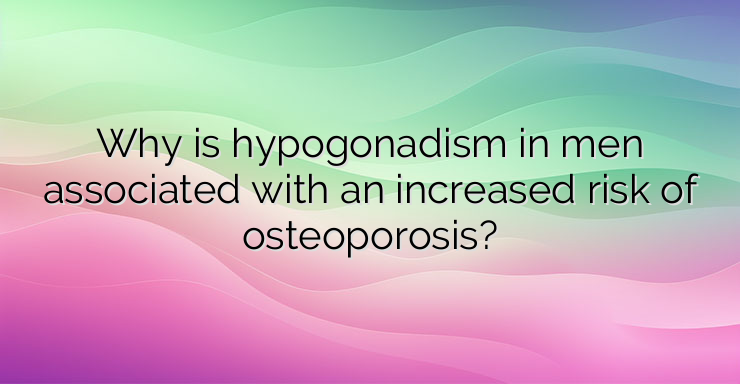Male hypogonadism is a disorder caused by decreased testosterone levels, resulting in low sperm count, multiorgan dysfunction, and poor quality of life. Osteoporosis is a debilitating condition that causes bone loss, leading to a significant risk of fractures due to bone fragility and an increased risk of death. Historically, osteoporosis was considered primarily a disease affecting postmenopausal women. This is because bone loss is relatively rapid after menopause due to decreased estrogen levels. The presence of osteoporosis in men is still not recognized and not adequately treated. However, in recent years, the high incidence of fractures due to bone problems in men highlights the importance of prompt recognition of osteoporosis in men. Male hypogonadism is associated with bone loss, but is not strictly related to testosterone levels. Estrogen levels are not usually considered in men when it comes to bone quality. However, levels of bioactive estrogen are thought to be strongly related to the maintenance of bone mass. Bone loss is said to be increased in hypogonadism. Obesity is considered the most common cause of hypogonadism in men. The pathophysiology of hypogonadism associated with obesity is related to strong aromatase activity in adipose tissue. An increase in adipose tissue is associated with an increase in the enzyme aromatase, which converts testosterone to estradiol and results in decreased testosterone levels that favor the deposition of visceral fat. About 1 to 2% of serum testosterone is free in the circulation as bioavailable testosterone, while 98 to 99% is bound to albumin and Sex Hormone Binding Globulin (SHBG). Approximately 40 to 50% of testosterone is bound to albumin and about 50 to 60% to SHBG. The enzyme 5 alpha reductase converts testosterone to dihydrotestosterone (DHT), which binds strongly to the androgen receptor or aromatizes to estrogen. About 20% of the dihydrotestosterone in the blood is secreted by the testes, while 80% is produced by the conversion of testosterone in peripheral tissues. Men who are at greater risk of osteoporotic fractures are those who are being treated for prostate cancer with androgen deprivation therapy (androgen deprivation therapy), those who have had osteoporotic fractures in the past, and those , taking oral glucocorticoids. Testosterone and estrogen levels decline gradually in men as they age, but in women, estrogen levels decline rapidly during menopause, leading to increased bone loss. Men tend to lose trabecular bone (the spongy substance, a spongy meshwork inside the bone) after age 40, but not as rapidly as women.Primary osteoporosis is usually caused by advancing age or idiopathy (a disease that has no known cause), while secondary osteoporosis is caused by alcohol abuse, oral glucocorticoid treatment, and hypogonadism. The role of sex hormones in the development of osteoporosis is particularly important. About 85% of the estrogen in the blood originates from the aromatization of testosterone in the peripheral tissue. The level of sex hormone-binding globulin (SHBG) increases with age, leading to the need to assess testosterone and estrogen levels. It is well known that the rate of loss of bone mineral density depends more on estrogen levels than testosterone. It is also said that the increase in bone turnover is inhibited (suppressed) by estrogen in aging men, not by testosterone. Parathyroid hormone or parathormone (PTH) is another cause of bone loss in older men, partly due to deficiencies in vitamin D, growth hormone, and insulin-like growth factor-1 (IGF-1). References: 1. Rochira V, Balestrieri A, Madeo B, Zirilli L, Granata AR, Carani C. Osteoporosis and male age-related hypogonadism: role of sex steroids on bone(patho) physiology 2. PubMed. Sutton RA, Dian L, Guy P. Osteoporosis in men: an underrecognized and undertreated problem 3. Golds G, Houdek D, Arnason T. Male hypogonadism and osteoporosis: the effects, clinical consequences, and treatment of testosterone deficiency in bone health 4. Rao SS, Budhwar N, Ashfaque A. Osteoporosis in menclinical consequences, and treatment of testosterone deficiency in bone health 4. Rao SS, Budhwar N, Ashfaque A. Osteoporosis in menclinical consequences, and treatment of testosterone deficiency in bone health 4. Rao SS, Budhwar N, Ashfaque A. Osteoporosis in men


Leave a Reply